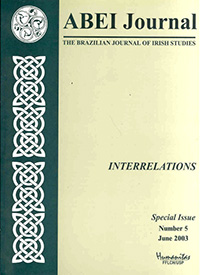Portrait – In the Middle of Reality and Illusion: Analysis on The Picture of Dorian Gray and “The Oval Portrait”
DOI:
https://doi.org/10.37389/abei.v5i1.182271Palavras-chave:
Oscar Wilde, Egdar Allan Poe, Literatura Irlandesa, Retrato, IlusãoResumo
A portrait is resemblance of man and a form of painting, which retains the appearance of mortal human semi-eternally. The mysterious aspect of the portrait is used as a motif of stories by fantastic and mystery storywriters. In Oscar Wilde’s The Picture of Dorian Gray (1891), beautifully completed picture mars the protagonist’s pure mind. Instead of he growing old and his vices show up in his face, they appear in his portrait. The ugliness of the picture which represents the degradation of the protagonist’s mentality, causes some kind of terror to the readers beyond the category of beauty as an art form. A half-century before, Edgar Allan Poe wrote a short story called “The Oval Portrait” (1842). A beautiful portrait of a maiden is drawn by her painter husband in lonesome castle. The progress of painting is life-taking processes; as the portrait approaches its completion, she grows weak, and when it is done, her life ends as if it is absorbed by the painting. The two stories of Wilde and Poe have the common element: the portraits are accomplished in a beautiful state but they destroy the life or the spirit of the model. Here, we see the two aspects of the portrait; a beautiful object as a genre of pictorial art and a mysterious object which semi-eternally retains the figure of the mortal model. Focusing on the two stories, the first section of the essay considers their subject, a portrait, and analyse the origin and fantasy of it. In the second section, the relation between the human portrait and life is analysed. Because of its characteristics, coping and retaining human’s figure, a portrait is also considered as an object reflects the mind of the model. In the third section, a portrait is compared to the image of mirror and examined as a reflection of self. Finally, in the section four, the illusion of a portrait which interacts with the idea of gothic literature is discussed.
Referências
Alberti, Leon Battista. On Painting. trans. Cecil Grayson, London: Penguin Books, 1991.
Boardman, John (Ed). The Oxford History of Classical Art. Oxford: Oxford Univ. Press, 1993.
Brilliant, Richard, Portrait. London: Reaktion Books Ltd., 1991.
Burke, Edmund. A Philosophical Enquiry into the Origin of our Ideas of the Sublime and Beautiful. London: Routledge and Kegan Paul, 1958.
Campbell, Lorne “Portraiture”. The Dictionary of Art. New York: Macmillan Publishers Ltd., 1996.
Dorigo, Wladimiro. Late Roman Painting: A Study of Pictorial Record 30 BC – AD 500. trans. James
Cleugh and John Warrington, London: J. M. Dent & Sons Ltd., 1971.
Ellmann, Richard. Oscar Wilde. London: Hamish Hamilton, 1987.
Fornäs, Johan. Cultural Theory and Late Modernity. London: Sage Publications, 1995.
Jackson, Rosemary. Fantasy: the Literature of Subversion. London: Routridge, 1988.
Kant, Immanuel. Critique of Judgement. Trans. Werner S. Pluhar, Indianapolis: Hackett Publishing Comp., 1987.
Libre de Paris (Ed.). Les grands Maîtres de la Peinture. Paris: Hachetter, 1989.
Poe, Edgar Allan. Edgar Allan Poe Essay and Reviews. New York: Literary Classics of the United States, Inc., 1984.
Poe, Edgar Allan. “The Oval Portrait”. The Complete Tale and Poems of Edgar Allan Poe. New York: Penguin Books, 1982.
Pope-Hennessy, John. The Portrait in the Renaissance. London: Phaidon Press Ltd., 1966.
Todorov, Tzvetan. The Fantastic: a Structural Approach to a Literary Genre. trans. Rechard Howard, Cleveland: The Press of Case Western Reserve Univ., 1973.
Wilde, Oscar. Plays, Prose Writings and Poems. London: Everyman, 1996.
Wilde, Oscar. The Picture of Dorian Gray. Oxford: Oxford Univ. Press, 1981.
Downloads
Publicado
Edição
Seção
Licença
Copyright (c) 2003 Chiaki Kojima

Este trabalho está licenciado sob uma licença Creative Commons Attribution-NonCommercial 4.0 International License.


